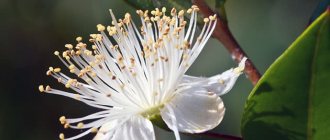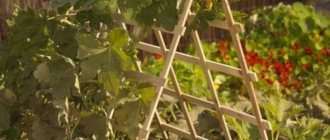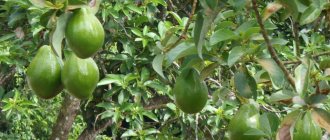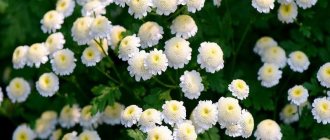SHARE ON SOCIAL NETWORKS
FacebookTwitterOkGoogle+PinterestVk
Raspberries are a very common and beloved berry by many. The fruits ripen early, smell wonderful, and also have excellent taste. The plant propagates easily and quickly. From a bush planted in spring, you can get a small harvest in the second year. And if you choose the right place for planting, the yield can be increased. A raspberry trellis will help simplify plant care. This article will tell you about the features of planting shrubs using supports.
To make raspberries tasty and healthy, it is important to properly care for the plant.
Choosing a time and place to plant raspberries
Most berry bushes can be planted in the ground in autumn or spring. Raspberries are no exception in this regard. It is impossible to say unequivocally when exactly to plant young plants. Everything is determined by the characteristics of the local climate.
In warm southern regions, which are characterized by late and mild autumn, local gardeners prefer to plant raspberry bushes from late September to mid-October. At this time it is no longer hot. Before the cold weather, the seedlings have time to take root well; in the spring they will not need additional time for this and will immediately begin to actively grow. The first harvest can be expected in mid-summer. But there is always a risk of young plants freezing, since they are not yet strong enough.
In warm southern areas, raspberries are planted before winter
Only in the most extreme cases, when it was not possible to deal with the bushes in the fall, are they planted in the spring (late February or early March). Planting times are extremely short, since spring in the south is fast and hot, almost immediately turning into summer. Planted shrubs may not have enough moisture for normal development. They quickly throw away the buds without having time to properly form the root system. The survival rate of spring seedlings is significantly lower.
In regions with a cold continental climate, harsh and long winters that arrive early can destroy plantings, especially if there is little snow, so most gardening work is postponed to spring. After the snow cover has melted, when the positive temperature remains stable (not lower than +5...+7 °C) and the soil has warmed up sufficiently, planting material can be prepared. Raspberries are planted from the end of April until about mid-May, trying to catch them before the sap begins to flow and the buds open. Usually the ground is well saturated with melted snow water, but if the spring turns out to be hot and dry, then the raspberry tree needs to be watered regularly and abundantly.
In the northern regions, it is better to plant raspberries in the spring
In the middle zone, the specific time of planting is determined by the winter hardiness of the variety. Frost-resistant varieties can be safely planted in the fall. With less winter-hardy species, it is better to wait until spring warmth.
To organize a raspberry garden, you need to select open, well-lit places that are protected from strong gusty winds and drafts. The culture tolerates light openwork partial shade, but in some varieties the taste of the fruits is sharply reduced and the plants themselves are greatly retarded in development. It is not recommended to choose areas located on steep slopes or hills, since moisture is poorly retained there and the bush will suffer from its lack. Raspberries do not like excess moisture. It reacts extremely negatively to the proximity of groundwater. If the aquifer lies closer than 1 m to the surface of the earth, then the seedlings may die from lack of oxygen or from the appearance of rot on the roots.
Raspberries should be planted where the snow melts faster
It has been confirmed by the experience of more than one generation of gardeners that the ideal place to place raspberries is along the fence, and preferably on the south side. Areas near the walls of various outbuildings (bathhouse, barn, etc.) are suitable, since the buildings protect the bushes from cold northern winds. In these places, the snow should melt faster in the spring and the soil should warm up.
It is best to plant raspberries along the fence
On our site, raspberries grow in one row in the direction from west to east along the neighbor’s fence on the north side, but at some distance from it (about 1.5 m). The fence is made of corrugated sheets, which have a light gray protective coating and reflect light well. The raspberry bush does not lack light and feels great. The place turned out to be a little damp, but the bush was planted on a high ridge and was not in danger of stagnating moisture.
Preparing the soil and pit for planting raspberries
When organizing a raspberry garden, decisive importance is attached to proper soil preparation. The landing site must be carefully prepared and it is better to do this in advance. The earth needs to be dug up to a depth of at least 25–30 cm, and root shoots and rhizomatous plants must be selected. All manipulations are carried out in advance, at least 2-3 weeks before the expected planting day, so that the soil has already settled and compacted. When planting raspberries in spring, all preparatory work is carried out in the fall.
The place for planting raspberries must be prepared in advance.
Raspberries grow best on moisture-intensive, well-drained sandy loam and loamy fertile soils with a neutral or slightly acidic reaction. If necessary, the soil is deoxidized by adding fluff lime or dolomite flour. Acidity is determined in specialized laboratories or at home using litmus paper (can be purchased at any gardening store).
When growing raspberries on sandy soils, you will have to regularly apply organic fertilizers (humus, manure, etc.) and water more often, since sandstones do not retain moisture well. You can make a cushion from a clay substrate at the bottom of a planting container or ditch. Peat soils are enriched with sand in advance (4 buckets per 1 m2). In heavy clay soils, it is recommended to equip a drainage layer of coarse crushed stone, stones or broken bricks.
Humus and fertilizers must be added to the hole or trench
It is advisable to treat the soil with insecticidal preparations to destroy the larvae of harmful insects (chafer beetle, wireworm, etc.).
Pits or trenches for planting are prepared as follows:
- dig a planting hole or ditch of the required length, 0.45–0.5 m deep and about 0.5 m wide;
- Coarse plant remains (stems, tops, bark, branches, etc.) are placed at the bottom of the ditch;
- then lay out a layer of fine vegetation (mown grass, straw, etc.);
- A soil mixture of garden soil and humus (compost), taken in equal proportions, with the addition of wood ash is placed on top.
Organic matter (3–3.5 kg) or mineral fertilizers (saltpeter or urea - 15 g, superphosphate - 30 g, potassium salt - 10 g) are added to the hole under each bush. It is better to combine fertilizers by applying them together, but in half the dose.
Selection and preparation of raspberry seedlings
It is extremely important to choose the right planting material . The health of the entire raspberry tree and its fruiting will depend on the quality of the seedlings.
It is very important to choose the right planting material
It is recommended to adhere to the following selection parameters:
- The plant should be young with average thickness of stems (5–8 mm), each of them should have at least 3–4 healthy buds. The shoots are shortened, leaving about 25–30 cm.
- The bark on the stems is brown, shiny and smooth, without damage, knots, cracks or various questionable spots. Peeling bark indicates that the bush is old.
- The root system is branched and fibrous, well developed (at least 15–25 cm long), healthy (without rotten or dry areas).
A good raspberry seedling should look healthy
Before transportation, the root system is wrapped in a wet cloth and placed in a plastic bag . Prolonged storage in polyethylene is unacceptable, since the delicate roots may begin to rot. Upon arrival at the site, the seedling must be buried immediately. The plant can be left in the air for more than a day, since raspberry roots are extremely sensitive to drying out. For better preservation, you can dip the root system in a clay mash. It is prepared from clay, which is diluted with water to the state of liquid sour cream, and a small amount of mullein is added.
Before planting, it is recommended to dip the raspberry seedling in a clay mash
Immediately before planting, the roots are moistened with water or briefly dipped in an earthen solution (½ bucket of fertile soil is filled to the top with water). If the seedlings were dug up quite a long time ago, then they need to be soaked in water for 5–6 hours, and then the root system should be treated with any root formation stimulant (Kornevin, Zircon, Epin, etc.).
You need to purchase planting material only from reliable suppliers with a good reputation. You shouldn’t be fooled by cheap prices and buy seedlings on the market from completely unfamiliar sellers.
Our neighbors have very good large and sweet raspberries. They dug up the shoots right in front of us and we immediately planted them in the right place. This option for purchasing seedlings is optimal; it guarantees the varietal purity of the planting material.
Biological features of the species
Common raspberry (Rubus idaeus) belongs to the Rosaceae family and is a deciduous subshrub with a two-year development cycle of the aerial part and a perennial rhizome. In the first year after planting, buds form on the rhizomes, from which one or two replacement shoots grow. When leaves appear on the shoots, several buds are formed in their axils: one of them is the main one, and the rest are additional. With the onset of autumn, the shoots acquire a color characteristic of this variety. Raspberry leaves fall late - with the onset of constant frost.
In the spring of next year, fruit branches grow from the buds formed on last year's shoots - flowers appear on them, and then fruits. Raspberry flowers are bisexual, self-pollinating; pollination is also facilitated by bees and other insects that willingly visit the blooming raspberry tree.
The flowering of the plant lasts from 2 to 3 weeks, and one flower lasts from 3 to 5 days
In the current growing season, new buds are formed on the rhizomes and roots, from which replacement shoots and suckers grow again. And last year’s stems dry out after fruiting is completed.
In practice, raspberry fruits are usually called "berries". But from a biological point of view, this is not entirely true, since in botany a berry is considered a juicy fruit with a dense shell and many seeds, like currants, grapes, and gooseberries. The raspberry fruit is a complex drupe ; if you look closely, you can clearly see that it consists of small round fruits, inside each of which there is one tiny seed. These fruitlets grow together and are located on an overgrown receptacle. When ripe, they are easily separated from the receptacle.
The color of the fruit varies from yellow to dark red, depending on the variety, shape - from spherical to conical, size up to 3-5 cm
The raspberry root system consists of adventitious roots that form on the rhizome, as well as overgrowing ones. Most of the roots are located at a depth of 10 to 20 cm at a distance of 30-60 cm from the stem. On their branched sections, buds are formed, giving rise to daughter plants, united with the mother by a common root system. Shrubs can grow strongly and occupy large areas. Under natural conditions, raspberries are usually found on forest edges, on river banks and clearings, where they have long been collected. In the old days, the strongest and healthiest plants were often dug up and planted in personal plots. The first varieties of garden crops were bred in the 16th-17th centuries in Europe.
Methods for planting raspberry bushes
There are several different options for planting raspberry bushes.
Bush
The bush method is most often used by gardeners and summer residents; it involves planting raspberry bushes in holes. In this case, preliminary preparation of the site is not necessary; all fertilizers are applied directly at the time of planting. The method is convenient when there is no room for an extensive raspberry patch, but it is planned to plant several bushes in different places.
The bush method of planting raspberries is the most common
The sequence of work is as follows:
- The site is being marked. About 1.5–2 m are left between rows, and 0.7–0.9 m between neighboring plants.
- Holes are dug with a diameter of 0.5–0.6 m and a depth of 0.5 m.
- Pour a bucket of humus (compost), superphosphate (30–35 g), and potassium salt (20–25 g) into the bottom of the hole. All components are mixed well with the top layer of fertile soil.
- A seedling is placed in the center of the hole. The root system is carefully straightened and distributed throughout the entire space of the hole. In order for the soil to evenly fill the free space between the roots, the bush needs to be lifted several times and shaken a little while filling the hole.
- The filled hole is compacted and a depression is made around the entire perimeter for watering. The growth point should be at ground level.
- Water generously.
- Mulch with sawdust, grass clippings, peat, straw, etc.
With the bush method, a raspberry seedling is planted in a hole
It is not recommended to use poorly rotted manure, as it attracts cockchafers and mole crickets.
Video: the process of planting a raspberry seedling
Trench
The option of landing in a trench is considered more labor-intensive and time-consuming. Most often it is used for industrial cultivation of berries in large volumes. Its main advantage is that the raspberry plant is fertilized evenly from the very beginning. Therefore, the quality of fruiting will be higher, the yield will increase several times.
Raspberries planted in trenches are fertilized more evenly
The planting process consists of the following steps:
- Marking is carried out on the selected area. Drive pegs into the corners and stretch a rope or cord over them.
- Using a stretched cord, a trench is dug 0.4–0.5 m deep and about 0.5 m wide.
- At least 1.2 m is left between adjacent trenches.
- A 10 cm thick nutrient layer of dry leaves, mown grass, tops, etc. is placed at the bottom of the ditch.
- At least 10 cm of fertile garden soil or peat is poured on top of the organic matter.
- Seedlings are placed on top at intervals of 0.4 m.
- The ditch is successively covered with earth, carefully holding the plants.
- The soil is compacted and watered.
A trench is dug according to the markings
It is more convenient to work together with a partner. One person holds the bush vertically by weight, and the other fills the trench with earth.
Video: trench method of planting raspberries
Container
For areas with a small area, some gardeners practice planting raspberry bushes in various containers without a bottom. This can be a large plastic bottle (without a neck), a metal bucket or barrel, a spacious saucepan and other old containers with a diameter of 0.45–0.5 m and a height of at least 0.5–0.6 m. The container is buried in the ground, then filled with fertilized fertile soil mixture.
Planting raspberries in containers is especially suitable for small areas
The walls of the vessel prevent the uncontrolled growth of shoots. When watering and liquid fertilizing, the nutritious moisture remains inside and does not spread around.
In tires
An original and interesting option for the container planting method is planting in old car tires, which also prevent the raspberries from spreading beyond the designated area. Large diameter tires from a truck or tractor are better suited.
You need to proceed as follows:
- dig a hole to a depth of approximately half the height of the tire;
- the sidewalls of the tire are cut off (optional);
- a tire is placed in the recess so that its edges are 10–15 cm above ground level;
- the internal volume of the tire is filled with a soil mixture of humus (garden compost), wood ash, garden soil and mineral fertilizers;
- Raspberry bushes (up to 3 pieces) are planted in the center;
- Water generously and mulch.
Raspberries planted in old car tires look very original
The tire beads retain moisture during watering and prevent liquid fertilizers from spilling.
The raspberry bush looks like a kind of berry flowerbed.
There are never any problems with finding landing containers, since any car enthusiast always has this stuff in abundance. At every tire shop, the sufferer will be happy to be provided with old tires. The fact is that recycling used tires costs money, so specialists are not averse to saving a little and at the same time getting rid of the trash.
Video: raspberries in old car tires
Tape
Planting with ribbons involves forming rows (strips) of raspberry bushes. With this method, individual plants are located closer to each other than with a bush method. They are placed at a distance of 0.3–0.5 m, while the row spacing is, on the contrary, wider - 1.5–2.5 m. With such dense planting, the strips are filled with shoots faster and the onset of full fruiting is accelerated.
When planting in strips, raspberries leave very wide row spacings.
Unlike the trench method, the tapes are usually made wider (from 0.4 to 1 m). In a dug trench, seedlings are placed in several rows (3–4). The productivity of such strips is much higher, but it is also more difficult to care for them.
DIY trellis: selecting materials for construction
Raspberries need support already in the second year after planting. Therefore, a trellis for shoots should be installed within the first two years. It is best to place poles and anchors immediately after planting. Next spring, even before the snow has completely melted, while the poles are firmly held in the frozen soil, it is necessary to tension and secure the wire.
To make trellises, you can use reinforced concrete posts or metal pipes of small diameter
Standard reinforced concrete structures with a cross section of 10×10 cm can be used as pillars. Substandard pipes with a diameter of 8-10 cm are also suitable for these purposes. Wood can also be used.
The total length of the poles is 2.2-2.5 m, while their height above the soil surface is 1.5-1.8 m. Before installing them on a raspberry field, metal poles are treated with anti-corrosion substances, for example, immersed in a bath of bitumen, and wooden ones - with antiseptics (soaked for 2-3 days in a solution of copper sulfate). The optimal distance between posts on a plantation is 10-20 m. For 1 hectare you will need from 200 to 400 pieces.
The posts at the end of the row must be additionally secured with anchors. Stainless steel wire is perfect for tensioning between vertical supports. But it is best to use a polyethylene-coated product, polyamide wire or reinforced polyethylene (or propylene) twine.
Each shoot of the plant is tied separately. The stems can be attached to the main wire with another long thread of soft wire or twine, braiding the main thread along with the shoots. The ends of the twine are secured to the outermost posts.
Wood is great for making your own trellises
Helpful advice! When creating a double-sided trellis, the costs will be 30% higher than when creating a one-sided trellis, and 70% more than when constructing a vertical one.
Rules for planting remontant raspberries
Remontant varieties of raspberries can be planted at any time: both in autumn and spring. However, it is believed that autumn is preferable for this, since with the onset of warmth the bushes immediately begin to actively develop and will produce their first good harvest in the summer. When planted in spring, fruiting will be later and not very intense.
Remontant raspberries are more demanding and capricious in terms of illumination, as well as the degree of moisture. When grown even in light partial shade, the berries will ripen later and will not be as sweet. Insufficient watering will directly affect the size and quantity of fruits.
Remontant raspberries should be planted in a place well lit by the sun.
The landing rules are as follows:
- The soil should be neutral or very slightly acidic. If necessary, it is deoxidized with dolomite flour and fluff.
- The beds are prepared in advance. When digging, add per 1 m2: humus - 2 buckets, potassium sulphide - 1 cup, superphosphate - 1 cup.
- Bushes are planted in holes or trenches 0.5–0.6 m deep and 0.5 m wide. Plants are placed at a distance of about 0.5–1 m from each other, row spacing is at least 1.2–1.5 m.
- Fill and compact the soil.
- Sprinkle generously with water - 5–6 liters per bush.
- Mulch with bark, plant debris, grass clippings, etc.
Not having the appropriate knowledge at the right time, we planted remontant raspberries in the shade of a large apple tree. The berries on it are noticeably less tasty and sweet than those of ordinary raspberries growing nearby. Although the bushes are growing and developing well.
Seedling care
However, it is not enough to know how to plant raspberry seedlings. You also need to have an idea about caring for them in the first days after planting.
The most important thing is not to let it dry out. The root system of the bushes is very weak and they will not be able to get a lot of moisture from the soil. Therefore, you need to water them regularly, unless there is heavy rainfall.
Also, don’t forget about mulching. This is a really good solution. On the one hand, a thick layer of mulch successfully suffocates small weeds - they do not have time to break through it and simply die. On the other hand, mulch saves moisture. A strong wind dries out the top layer, while the soil remains moist, which means you won’t have to water the raspberry beds too often. Various raw materials can be used as mulch: sawdust, chopped dry grass, leaves, pine needles, manure. Gradually they will rot and nourish the soil with useful substances that stimulate the growth and development of plants.
In the first days after planting, some experienced gardeners even specially shade the raspberry bushes, protecting them from direct sunlight. This is also a good solution - being in the shade, plants lose less moisture, which allows them to develop more actively. After one or two weeks, the shading can be removed - by this time the bushes will have acquired a sufficiently developed root system to receive enough moisture from the ground.
Industrial planting of raspberries
To plant raspberries over large areas, root suckers are used, which are specially grown in nurseries. To locate raspberry plantations, gentle, flat slopes are selected (slope no more than 5°), protected from the prevailing winds. But protective plantings should not shade the berry bushes.
Raspberries are grown on an industrial scale
Work is carried out in autumn or early spring. When plowing, fertilizers are applied to the ground at the rate of 1 hectare:
- organic - 150 t;
- potash - 0.3 t;
- phosphorus - 0.2 t.
Planting is carried out using the belt method using special machines (SLN1 and SSHN3) according to the following scheme:
- row spacing - 1.5–2 m;
- distance between seedlings - 0.3–0.5 m;
- embedment depth - 0.2 m.
Then the young plantings are mulched with peat - 15–20 tons per 1 ha.
Planting raspberries is carried out using special planting units
Industrial cultivation of raspberries in our country is currently poorly developed. But during the Soviet Union, there were large raspberry fields in every fruit nursery. After the harvest, ordinary citizens were released onto the plantations, who could pick the remaining berries on the bushes and then buy them for next to nothing.
Video: industrial method of planting raspberries under film
Cons of a hedge
- Raspberry roots grow quickly, producing numerous young shoots.
- Small and sour berry.
- Constant work with cutting out unnecessary sprouts.
- It is difficult to loosen the soil, cover it, and cut out old shoots.
More on the topic: Raspberry tree: how to plant and care
Conclusion
A hedge has the triple benefit of decoration, fencing, and harvest. In addition, an unusual fence pleases and calms the nervous system. Bees pollinate not only raspberries, but also other plantings in the garden.
Compatibility of raspberries with other plants when planting
Correct agricultural technology does not always guarantee a good harvest. The fruitfulness of a berry garden is largely determined by its neighbors growing nearby—companions. It is highly not recommended to place raspberries and strawberry beds in close proximity to each other. These crops have common diseases and pests, which they successfully share among themselves. In addition, the root systems lie at the same depth, which makes them competitors in the struggle for nutrients.
Raspberries feel bad and bear poor fruit next to cherries, even if they grow at a distance of 4–5 m. Currants and sea buckthorn impoverish raspberry plantings, taking away nutrition. Therefore, they are not good neighbors either. Raspberry bushes do not like to grow after tomatoes or potatoes; it is better to wait 2–3 years before planting in this place. Marigolds, nasturtium, radishes and parsley have a negative effect on the development of shrubs.
There are compatibility tables for various fruit and vegetable crops
The optimal location of a raspberry tree next to an apple tree, pear tree, plum tree, honeysuckle and barberry is considered optimal. Garlic, onions or red elderberries planted nearby will repel pests from raspberry plantations.
The best predecessors will be cereals or legumes. They will saturate the soil with nitrogen, and also make it looser and more nutritious.
Even the not very close location of raspberry and strawberry plantings has a negative impact on both crops. On our site they are located at a distance of about a meter from each other, and they adjoin in very small parts, almost only at the corners. In a damp summer, gray rot that appears on strawberries is instantly transmitted to the raspberry plant. As a result, we are left completely without berries.
Don't forget about the garter
For more convenient harvesting, you should also tie up the raspberry bushes. To do this, the rows are simply fenced off on all sides so that they do not fall under their own weight - sometimes the stems are up to two meters long.
The procedure is quite simple and does not require annual updating. Metal rods or reinforcement are dug or driven in along the edges of the rows. At a height of about 120 centimeters, a wire is stretched - galvanized, stainless steel or aluminum. Thanks to this, the raspberries will always stand strictly vertically, and harvesting will be significantly simplified - you won’t have to lift each bush with one hand in order to pick the berries with the other.











